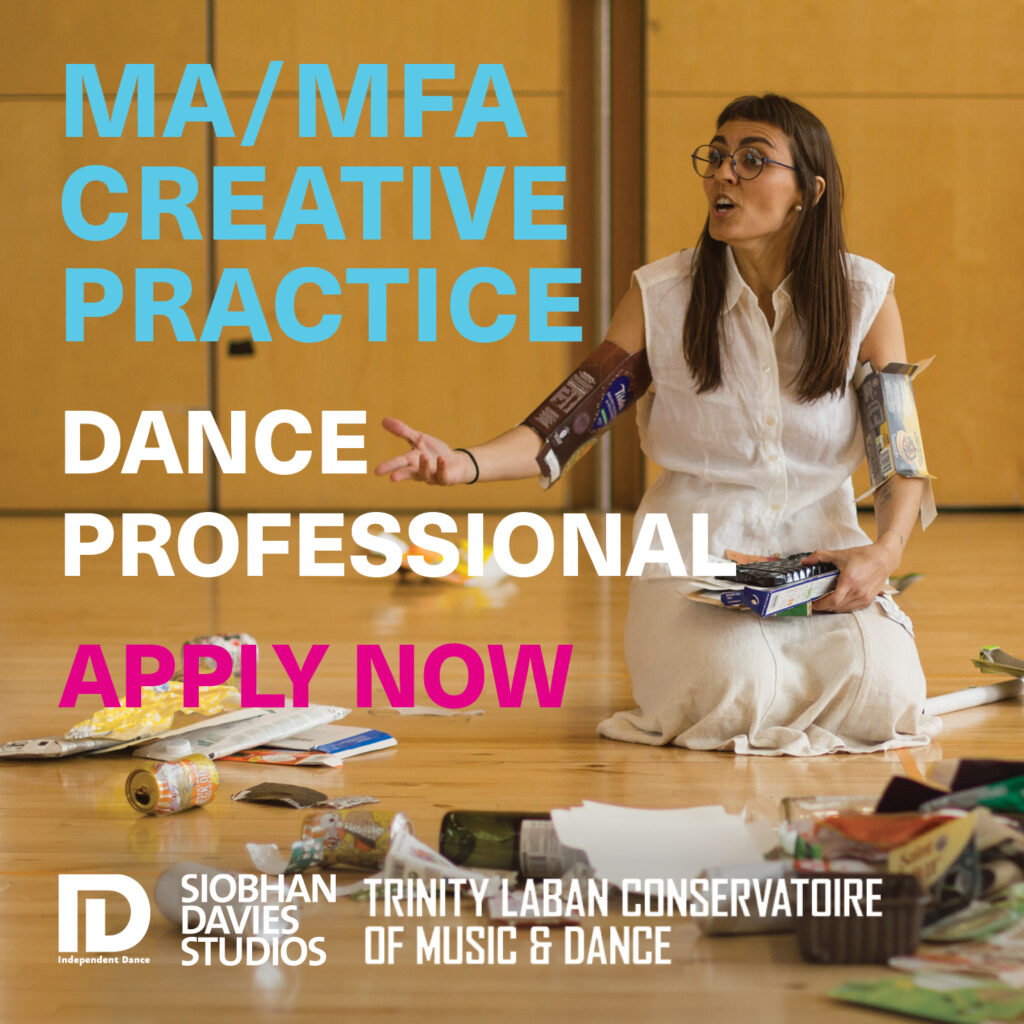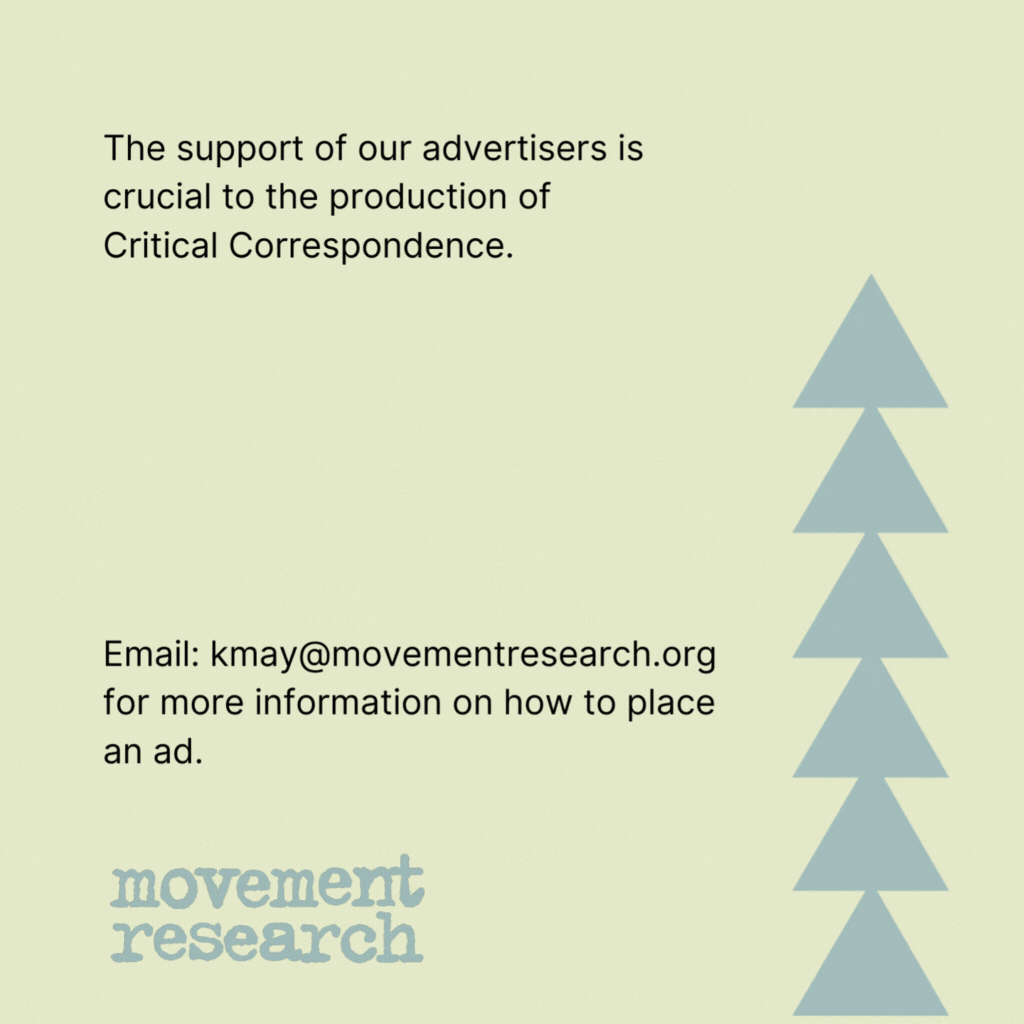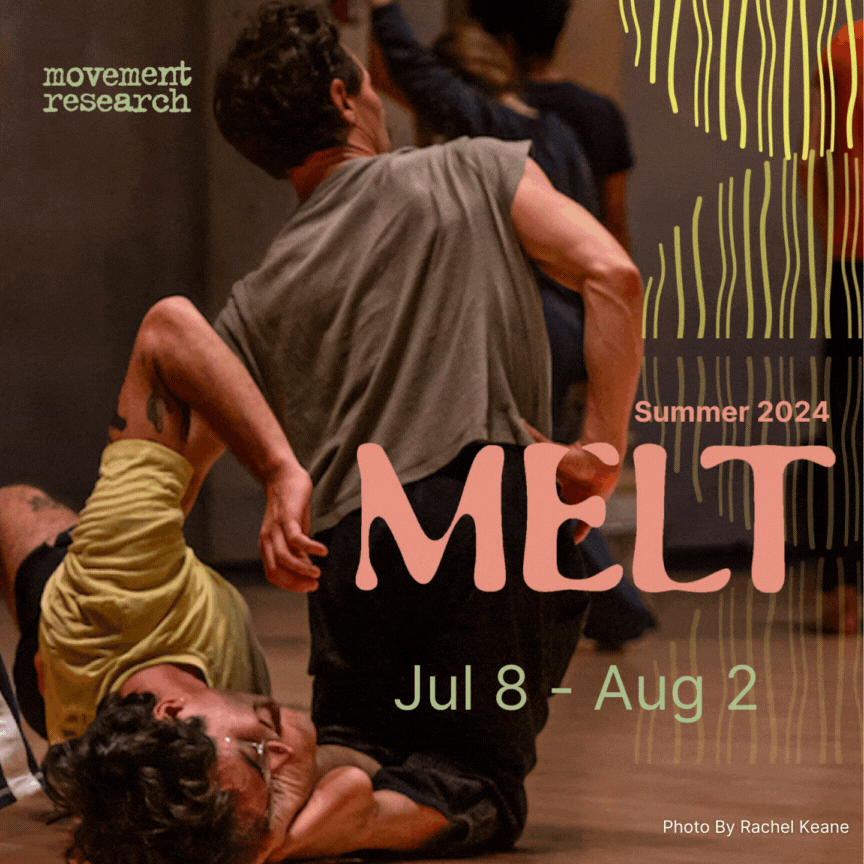The US component of the Netherlands’ highly regarded Springdance festival is a multinational partnership between Springdance, Dance Theater Workshop, and Dance Agency TSEH in Moscow. For a two–week period in October 2006, ten artists–in–residence at Dance Theater Workshop will engage in a dialogue about their artistic inspirations, ideas and working methods, leading to a series of performances that will introduce a next–generation of international artists and the unique questions that inform their work. The participating artists are: Daria Buzovkina (Russia), Eduard Gabia (Romania), Levi Gonzalez (US), Tatiana Gordeeva (Russia), Myriam Gourfink (France), Nora Heilmann (Netherlands), Krystyna Lhotakova (Czech Republic) Ivana Müller (Croatia/Netherlands), Nami Yamamoto (US), and Chris Yon (US).
I had the good fortune to be selected to participate in the NYC component of the DTW/Springdance Dialogue. This involved gathering ten artists from Europe, Russia and New York to present their work and discuss the issues, aesthetic and otherwise, that inform the work with moderators Andre Lepecki and Mihai Mihalcea. The participating artists, apart from myself, were Chris Yon and Nami Yamamoto (NYC), Eduard Gabia (Romania), Myriam Gourfink (France), Ivana Muller (Netherlands/Croatia), Nora Heilmann (Netherlands), Kristyna Lhotakova (Czech Republic), and Tatiana Gordeeva and Daria Buzovkina (Russia).
In an era of globalization and mass commercialization of culture, it’s nice to know that real physical geography is still important. Listening to artists’ responses to the environment in which they create and how it shapes their work is really heartening. So much of who we are and what we do is defined by context and place. Listening to people describe their local dance ecosystem gave incredible insight into the subtleties of the artist’s intention with the work and the contribution of environment to the formulation of aesthetic values. As I watched work from fellow New York artists, I could see our response to a very specific New York situation. I could see the American tradition of an entertainment industry and the dominance of pop culture, and our desire to play with those things and to resist them in a conscious way. In a general way (though each artist had a completely unique take on this), I could see western European artists responding to a tradition of theater, perhaps rejecting it or finding ways to rebel against it by taking it on on their own terms. This realization of the significance of context existed outside of aesthetic judgment. Like or dislike of the work was irrelevant. What mattered was the understanding that things matter, and that art is always in dialogue with the culture that surrounds it. In fact, that culturally specific relationship is what gives it resonance and meaning.
To look at my art-making practice as a specific dialogue with place, and not just an abstract “pure” form where innovation is held as the highest standard, is really useful in helping to identify the issues I wish to address in my work. The stipulation of having to present, via language, my own work and to listen to the translation of the work of others into language, helped to identify key issues of concern outside of the realm of taste. This is a valuable and frequently overlooked skill for an artist to have. Often it seems the only time one gets to talk about one’s work is in an interview for the press (where one is conscious of representing themselves to a public and selling the work and oneself) or in a grant proposal where the questioning nature of artistic discovery is snuffed out in the effort to present the most convincing case to get the money, the opportunity, the audience, etc. Both these models have a competitive aspect as well as the threat of failure. There is a real value in an aesthetic discourse that is more open ended, that allows for an expansion of thought rather than a reductive and eliminative process. It creates a possibility for creativity within the language that more closely resembles the creative process in making dances, and thus becomes a more accurate representation of one’s work than the typical grant language. As a developing artist, this kind of articulation about my work has many practical applications as well… a firmer understanding of how to present my ideas in language which can then filter into those other kinds of language – the ones that provide money and opportunity. But ultimately it’s the substance of the ideas that remains most meaningful as an artist attempting to clarify and understand his or her own sense of vision.
There is a palpable hunger for discourse in NYC. Often when artists come together to discuss issues the result is a series of rants about the difficulty of our situation, the politics, the money, the economic realities, the poor state of dance criticism. It seems relevant to bring up this lack here in Critical Correspondence, one of many current attempts to alleviate the lack of discourse by creating a forum for artists to communicate their ideas outside of more institutionalized formats. However, outside of the interview format, artists have yet to really use CritCor as a venue for dialogue within the artist community. I’m not sure why this is, but I have some hypotheses. I don’t think we are as comfortable with sharing artistic disagreements in the way western European artists are. In our effort to secure time and space, there is little room for talk. When I look at institutions like Tanzquartier in Vienna or Springdance in Utrecht, dialogue is built into the structure. Writers and theorists are invited into the discussion and integrated into the art world in a way that doesn’t exist here. Andre Lepecki, our moderator, gets much more work writing and talking about European dance than he does in his city of residence. I also generally find that artists are more OK with dissenting viewpoints about their work in Europe, and that NYC artists tend to be much more sensitive to criticism. Even amongst peers, there is a culture of politeness when discussing work, and the criticism tends to be reserved for when people of like-mind come together – a preaching to the choir. I too find it difficult to speak my mind to the artist who created the work if I don’t already have a firm friendship with them, unless it is something positive. I wonder if this is simply the result of having so little opportunity for discussion that we are less skilled at engaging in it. (I’m speaking here of a general situation, knowing full well there are many articulate, passionate artists who do engage in a substantive dialogue here with people who may not share their aesthetic values, and I have deep respect for them.)
After participating in the Springdance dialogue, I have a renewed desire to put this aesthetic discourse to the fore. I value so much the forums that do exist, notably the Movement Research Performance Journal and Critical Correspondence. I also sense that artists are continuing to create new situations for a discourse to happen… discourse about ideas, responses to our current political and artistic moment, failures and confusion. Artist-driven discourse about what it is that matters to us. The general press around dance here has really failed to present these undercurrents of thought. I think there may have once been hope that conceptual concerns would be directly addressed, but there seems to be no way to change the entrenched attitude of the mainstream press that a review is an opportunity to examine whether a work was an effective piece of theater, and not an opportunity to examine the ideas with which a work concerns itself. Maybe that shouldn’t be the function of a review, but it would be nice if there were a venue for this. Often I look at visual art and its critics’ and practitioners’ access to the history of the form and the concepts that inform it. This has not been integrated into the larger institutions surrounding dance. What is heartening is seeing artists who are creating their own opportunities for this and also institutions, such as DTW and Movement Research, that are listening to what artists want and trying to create more opportunities for these things to emerge. In the end, it is artists who must create situations to represent their own interests, and my feeling that momentum is gaining on that front gives me a sense of hope for the relevance of this form. I’m reminded of my interview with Jamm (also in CC) where she talks about how dance has nothing in terms of infrastructure and money, and that maybe that is a good thing, a privilege even. Certainly the simple act of getting together with an international collection of artists for the purposes of discussion is more valuable in terms of growth than fighting for the next gig.
P.S. In a post mortem meeting we discussed different possibilities for the dialogue format to continue. One idea that surfaced was a national dialogue. What if we got dance artists together from NYC, Philadelphia, Seattle, San Francisco, Minneapolis, etc.—artists from different aesthetic and regional backgrounds to see how they all respond to their unique situations? Especially in New York, where I think we are often viewed as having superiority complexes to outsiders, even as we view ourselves at the forefront of a struggle. Could be interesting, no?






